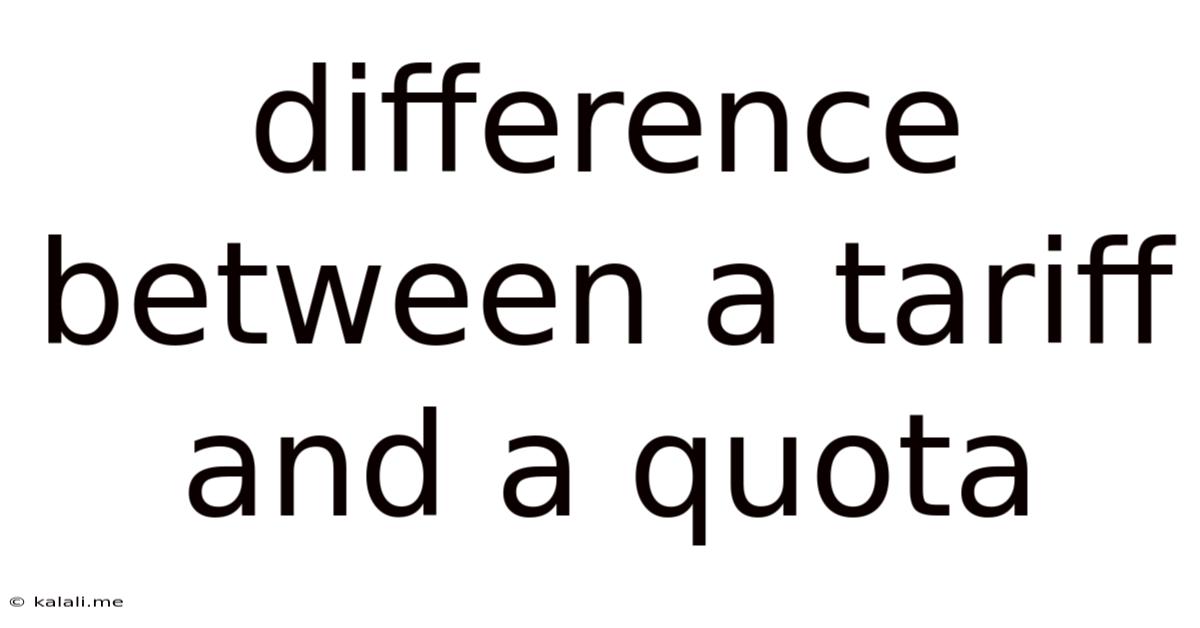Difference Between A Tariff And A Quota
Kalali
Jun 13, 2025 · 3 min read

Table of Contents
Tariffs vs. Quotas: Understanding the Differences in Trade Restrictions
Meta Description: This article explores the key differences between tariffs and quotas, two common trade restriction tools used by governments to protect domestic industries. Learn how they impact prices, imports, and overall market dynamics.
Governments employ various tools to manage international trade, with tariffs and quotas being two prominent examples. While both aim to limit imports and protect domestic producers, they achieve this through different mechanisms, leading to distinct economic outcomes. Understanding these differences is crucial for anyone involved in international business or economic policy.
What is a Tariff?
A tariff is a tax imposed on imported goods. It increases the price of imported products, making them less competitive compared to domestically produced goods. This price increase can lead to several outcomes:
- Reduced Consumption of Imports: Higher prices discourage consumers from buying imported goods, boosting demand for domestic alternatives.
- Increased Domestic Production: With reduced competition, domestic producers can increase their output and potentially expand their businesses.
- Government Revenue: The government collects revenue from the tariffs levied on imported goods. This revenue can be used to fund various public services or reduce other taxes.
- Potential for Retaliation: Imposing tariffs can provoke retaliatory measures from other countries, leading to trade wars and harming overall economic growth.
Tariffs are relatively straightforward to implement and administer. The tax rate is clearly defined, and the government can easily collect the revenue. However, they can lead to higher prices for consumers and stifle innovation by reducing competition.
What is a Quota?
A quota, on the other hand, is a quantitative restriction on the amount of a specific good that can be imported during a particular period. It sets a limit on the volume of imports, regardless of price. The effects of a quota are similar to tariffs, but differ in some key aspects:
- Limited Import Volume: The most direct effect is the restriction on the quantity of goods entering the country. This limitation directly reduces competition for domestic producers.
- No Government Revenue: Unlike tariffs, quotas do not generate direct revenue for the government. Instead, the benefit often accrues to those who hold import licenses or permits. This can create a system of rents and potentially lead to corruption.
- Potential for Price Increases: While quotas limit the quantity of imports, they can still lead to higher prices for consumers. The reduced supply can drive up the price of the imported good, even if it's below the level that a tariff would impose.
- Rent-Seeking Behavior: Quotas can create opportunities for rent-seeking behavior, where individuals or firms seek to profit from the quota system itself rather than from efficient production. This can involve lobbying for licenses or manipulating the quota allocation process.
Quotas are more complex to administer than tariffs. The government needs to monitor imports carefully to ensure the quota is not exceeded and manage the allocation of import licenses.
Key Differences Summarized:
| Feature | Tariff | Quota |
|---|---|---|
| Mechanism | Tax on imports | Quantitative restriction on imports |
| Price Effect | Increases price of imported goods | Can increase price of imported goods |
| Government Revenue | Generates revenue for the government | Does not generate direct government revenue |
| Administrative Complexity | Relatively simple to administer | More complex to administer |
| Impact on Supply | Reduces quantity demanded indirectly | Directly limits quantity imported |
| Potential for Rent-Seeking | Lower | Higher |
Conclusion
Both tariffs and quotas are trade restriction instruments used to protect domestic industries, but they operate through different mechanisms. Tariffs use price as a lever, generating revenue for the government, while quotas directly control the quantity of imports, often leading to rent-seeking behavior. The choice between a tariff and a quota depends on the specific policy goals and the government's administrative capacity. Understanding their differences is vital for analyzing trade policy effectiveness and predicting their economic consequences.
Latest Posts
Latest Posts
-
Mi Familia Fuera La M S Grande Correct Incorrect
Jul 01, 2025
-
How Much Is 20 Pounds Of Pennies Worth
Jul 01, 2025
-
How Much Does A Gallon Oil Weigh
Jul 01, 2025
-
How Many Crackers In A Sleeve Of Saltines
Jul 01, 2025
-
How Many Years Are In 48 Months
Jul 01, 2025
Related Post
Thank you for visiting our website which covers about Difference Between A Tariff And A Quota . We hope the information provided has been useful to you. Feel free to contact us if you have any questions or need further assistance. See you next time and don't miss to bookmark.